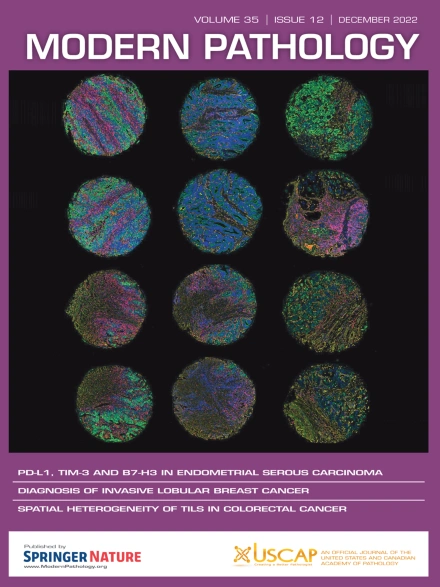甲基化分析揭示H3-3A突变骨肉瘤与骨恶性巨细胞瘤的表观遗传一致性
IF 5.5
1区 医学
Q1 PATHOLOGY
引用次数: 0
摘要
H3-3A基因热点突变是骨巨细胞瘤(GCTB)发生的关键驱动因素。罕见的原发性骨肉瘤也有这种突变,但它们的临床病理特征和分子特征,以及它们与常规和恶性GCTB (MGCTB)和高级常规骨肉瘤(HGOS)的关系在很大程度上是不明确的。在此,我们提出了一系列10例H3-3A突变骨肉瘤(BSH3-3A),并与常规GCTB、MGCTB和HGOS进行了临床病理、突变和表观遗传学分析。BSH3-3A包括6例高级别骨肉瘤,4例未分化多形性骨肉瘤,发生于女性7例,男性3例,平均年龄46岁(28-74岁)。肿瘤累及股骨(n=4)、距骨(n=2)、脊柱(n=2)、骨盆(n=1)和一个未知部位。2例股骨肿瘤累及骨骺。在大多数病例中,BSH3-3A表现为上皮样细胞和/或梭形细胞增生,核深染和明显的多形性,伴有或不伴有类骨细胞的产生。1例表现出低级别和高级别骨肉瘤成分。BSH3-3A的突变谱与常规HGOS不同,TP53突变频率明显降低。反映基因组复杂程度的基因组指数BSH3-3A也明显低于HGOS,但高于GCTB。DNA甲基化分析显示,大多数BSH3-3A和MGCTB病例形成一个明显的聚类,定位在GCTB附近,但与GCTB分离,与HGOS明显分离。差异甲基化分析显示,与HGOS和GCTB相比,BSH3-3A与MGCTB的相似性最高。生存分析显示BSH3-3A的结果与HGOS或MGCTB的结果没有显著差异。最后,BSH3-3A肿瘤虽然在放射学和组织学上与缺乏H3-3A突变的高级骨肉瘤相同,但表现出与MGCTB相似的表观遗传特征,并且具有明显低于HGOS的复杂基因组图谱,尽管临床结果相似。本文章由计算机程序翻译,如有差异,请以英文原文为准。
Methylation Analysis Reveals Epigenetic Congruence Between Bone Sarcomas With H3-3A Mutations and Malignant Giant Cell Tumors of Bone
Hotspot mutations in H3-3A gene are key drivers in giant cell tumor of bone (GCTB). Rare primary bone sarcomas also harbor this mutation, but their clinicopathologic characteristics and molecular profiles, as well as their relationship to conventional and malignant GCTB (MGCTB) and high-grade conventional osteosarcoma (HGOS), are largely undefined. Herein, we present a series of 10 H3-3A mutated bone sarcomas (BSH3-3A) with a comparative clinicopathologic, mutational, and epigenetic analysis with conventional GCTB, MGCTB, and HGOS. BSH3-3A comprised of 6 high-grade osteosarcomas, 4 undifferentiated pleomorphic sarcoma of bone and occurred in 7 women and 3 men with a mean age of 46 years (28-74 years). The tumors involved femur (n = 4), talus (n = 2), spine (n = 2), pelvis (n = 1), and 1 unknown site. Epiphysis involvement was noted in 2 femoral tumors. In majority of the cases, BSH3-3A showed cellular proliferation of epithelioid and/or spindle cells, hyperchromatic nuclei, and conspicuous pleomorphism with or without osteoid production. One case exhibited both low- and high-grade osteosarcoma components. The mutational profile of BSH3-3A was different than that of conventional HGOS with significantly less frequent TP53 mutations. The genomic index, which reflects the degree of genomic complexity, was also significantly lower in BSH3-3A compared with HGOS, yet higher than GCTB. DNA methylation analysis revealed that most BSH3-3A and MGCTB cases form a distinct cluster, positioned near but separate from GCTB, and clearly separated from HGOS. Differential methylation analysis revealed that BSH3-3A exhibited the highest degree of similarity to MGCTB in comparison to HGOS and GCTB. Survival analysis showed that outcomes for BSH3-3A do not differ significantly from those observed in HGOS or MGCTB. Finally, BSH3-3A tumors, although radiologically and histologically identical to high-grade bone sarcomas lacking H3-3A mutations, display epigenetic features similar to MGCTB and have a significantly less complex genomic profile than HGOS, despite comparable clinical outcomes.
求助全文
通过发布文献求助,成功后即可免费获取论文全文。
去求助
来源期刊

Modern Pathology
医学-病理学
CiteScore
14.30
自引率
2.70%
发文量
174
审稿时长
18 days
期刊介绍:
Modern Pathology, an international journal under the ownership of The United States & Canadian Academy of Pathology (USCAP), serves as an authoritative platform for publishing top-tier clinical and translational research studies in pathology.
Original manuscripts are the primary focus of Modern Pathology, complemented by impactful editorials, reviews, and practice guidelines covering all facets of precision diagnostics in human pathology. The journal's scope includes advancements in molecular diagnostics and genomic classifications of diseases, breakthroughs in immune-oncology, computational science, applied bioinformatics, and digital pathology.
 求助内容:
求助内容: 应助结果提醒方式:
应助结果提醒方式:


